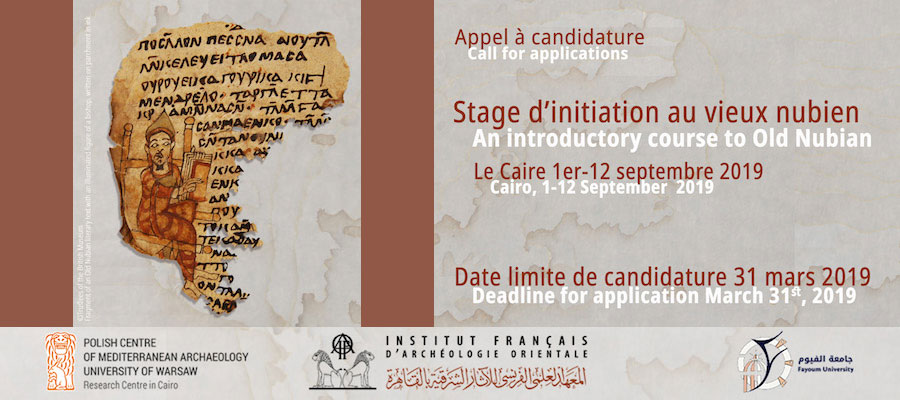Introductory Course to Old Nubian, Cairo, September 1–12, 2019
Old Nubian is the language used by the inhabitants of the Middle Nile Valley during the Middle Ages. Its oldest attestation dates back to the end of the 8th century CE and it continues to be used at least until the last decades of the 15th century with a peak of scribal activities in the 10th–12th centuries. Old Nubian belongs, with the modern Nubian languages (Nobiin, Kenzi-Mattokki, Dongolawi-Andaandi, Midob, and the Kordofan Nubian languages), to the Nubian language family, a branch of the Nilo-Saharan phylum. It was written using an adaptation of the Coptic alphabet developed in the 5th century through the addition of several signs from the Meroitic alphasyllabary. The preserved texts are of various natures and include literary texts (biblical, hagiographical, liturgical), documentary texts (contracts, correspondence) as well as inscriptions, both formal (the Memorial of King George from Wadi Natrun) and informal (numerous graffiti from Faras, Sonqi Tino, Banganarti...).
The idea of an introductory course in the Old Nubian language was born from the paradoxical observation that this rare language is currently not taught in any academic curricula, despite a clear increase in interest over the past ten years or so. In the continuity of the pioneering work conducted during the first decades of the 20th century (F.Ll. Griffith and E. Zyhlarz), modern studies on the Old Nubian language have long been dominated by the figure of the American philologist G.M. Browne. The latter was entrusted in the 1980s with the publication of the Old Nubian texts unearthed during the Qasr Ibrim excavations as well as the Serra East codex, the longest known Old Nubian text to date (a homily attributed to John Chrysostom). The analysis of this corpus allowed Browne to accomplish decisive advances in our understanding of this language. His work has been synthesized in his grammar and dictionary, which remain to this day the basic tools of every specialist in the field. A few years after Browne's untimely death in 2004, Old Nubian has sparked the enthusiasm of a new generation of researchers from diverse backgrounds, leading to new advances in the publication of texts and in the understanding of this language.
Among the latter, Vincent van Gerven Oei, a former student of J. van der Vliet in Leiden, has emerged in recent years as the best specialist of Old Nubian. He is the author of several articles on the subject and he is currently preparing a new grammar of Old Nubian, envisioned for the first time in its Nilo-Saharan linguistic context. Vincent van Gerven Oei will teach and supervise the students, in collaboration with Robin Seignobos (scientific member, IFAO), Arabist historian and specialist of medieval Nubia and Maher Eissa (associate professor of coptology, University of Fayoum).
Course Description
The course will take place from Sunday, September 1 to Thursday, September 12, 2019. The teaching will be given in English. The course is open to all students, researchers, and academics, provided that participants are able to cover their travel costs. However, the accommodation of the students and lunch will be provided by the organisers. Students will be welcomed and accommodated in the first week at the IFAO (Mounira) and in the second week at the PCMA (Heliopolis). During the first week, V. van Gerven Oei will give an overview of the morphology and syntax of the Old Nubian, while the second week will be devoted to practical exercises and text reading. Senior researchers, specialists in Old Nubian or other aspects of medieval Nubian civilization, will be invited to present their work during this two-weeks session.
Prior knowledge of Greek and/or Coptic is desirable but not mandatory. We plan to select a maximum of ten students so that the teaching can take place under the best conditions. This course will be of particular interest to students or researchers active in the field of Greek and Coptic papyrology and epigraphy, linguists specialising in African languages, and historians or archaeologists interested in Nubian history.
The course is supported by Institut français d’archéologie orientale, Polish Centre of Mediterranean Archaeology, University of Warsaw, and Fayoum University.
